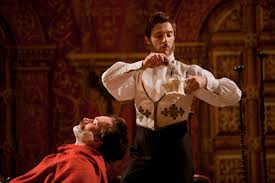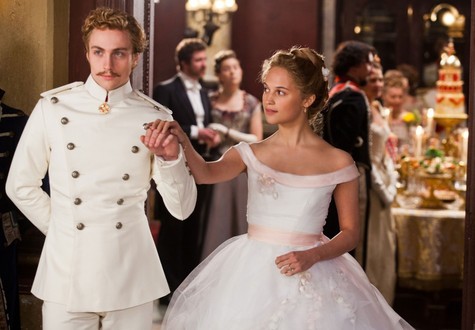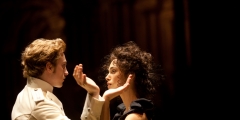I have misgivings about director Joe Wright’s treatment of the novel in his new film–how he understands Tolstoy and Anna. But the way the filmmaker animates the drama, with the crucial help of Belgian-Moroccan choreographer Sidi Larbi Cherkaoui, is absolutely exhilaratingly bold. For anyone wondering how pervasive choreography can be in a serious feature film, this movie is not to be missed.
Anna Karenina begins with the well-positioned bureaucrat Oblonsky (Matthew Macfadyen) laid out in a barber’s chair on a bare stage.
It is fitting in this starkly theatrical setting that the barber (Elias Lazaridis, one of thirteen dancers in the film from Cherkaoui’s Antwerp-based troupe, Eastman) behaves like a matador, snapping the barber’s sheet like a cape and flourishing the razors like lances. Mundane routine as ritual blood sport: how dangerous a world ringed round by custom can be.
And how mechanical: we follow Oblonsky, fresh from his ablutions, to the long chamber over which he presides, where row upon row of buttoned-up clerks stamp and rearrange papers in a syncopated ballet blanc: stamp, stamp, flutter of paper; repeat; repeat; repeat. The thick stack on the left shrinks as the thin stack on the right grows. “Paperwork,” Oblonsky later exclaims, “is the soul of Russia.” As he passes each row, his minions rise like pistons in a well-oiled machine to the music’s chug and wheeze.
If the opening scenes establish the world we’re in (richly adorned, deeply sublimated, and minutely calibrated) and how its story will be told (ebulliently, inventively, and, above all, theatrically), the ball — in which Vronsky (Aaron Taylor-Johnson) and Anna (Keira Knightley) whirl themselves into a passion and cast Kitty (softly radiant Alicia Vikander) aside — carries us into the story’s romance. Most directors appreciate the scene’s importance without making much of the dancing. (A notable exception is the 1935 Greta Garbo version, in which the dancers exchange not only partners but salty badinage.) Wright hands this pivotal moment over to the dance.
Cherkaoui set himself the task of inventing a variation on the waltz that would re-awaken it in all its allure. When he went “back into the books,” he says, “I read a lot about how the waltz was considered indecent. Not proper. It came from Poland” — a colonial outback by Russian lights — “but it seeped into the aristocracy, and people would do it because they couldn’t help themselves.
“I’ve always found this relationship between popular and aristocratic culture interesting. And here I was playing between these two: how we transform something to make it more proper but how at the end of the day it is still a man and a woman and their desire to fly away together.
“Waltzes can be like a cosmos,” he continues, “all these couples twirling around each other but also around the other couples. You would lean in to the arm of your partner in such a way that both partners have the feeling they have no weight.” They could spin all the way to the moon. They could fly too close to the sun. That thrill and danger resounds in the waltzes of Brahms, Tchaikovsky, Mahler, Ravel — and Marianelli, whose waltz for Anna and Vronsky grows progressively discordant the faster it turns.
“Anna and Vronsky’s passion is at the heart of the waltz,” Cherkaoui notes. The other couples freeze until the duo — “generating an energy like some kind of organic clockwork” — sweeps them along in its wake.
The choreographer did not meddle with the patterns of the feet — they lend the waltz its necessary force — but he embellished the arms and upper body to bring out the waltz’s strict comportment as well as its erotic appeal and to adapt it for the camera, which generally favors faces — “how people look at each other” — over feet.
To underscore the form’s exacting rules of engagement, he accented the man’s initial move: the raising of the back of the wrist to lead the woman on to the dance floor. Cherkaoui has the man’s wrist suddenly jut up. It doesn’t bode well for the lady otherwise. When Vronsky spots Anna after he has already agreed to give Kitty a turn, he lifts his wrist so desultorily that you feel the insult.
Bored Vronsky, entranced Kitty
As for the waltz’s legendary raciness, Cherkaoui began by thinking about the prescribed limits to touch at the 19th century ball: “You would hold the hand without the palms touching.” Only fingers were clasped. “Touching the inside of the hand was considered very intimate, very sensual.” In his version, only the lower arm’s pale undersides graze.
The hands are free to undulate and unfurl like time-lapse vines winding up trellises and flowering. “The looseness of the wrist only suggests touch. The hands flow through one another like weaving. I wanted the waltz to be magical, and you know how when you cast a spell it is with the weaving of hands?”
For more on Cherkaoui himself as well as his work on the film, including his coaching of the actors, click here.




Leave a Reply